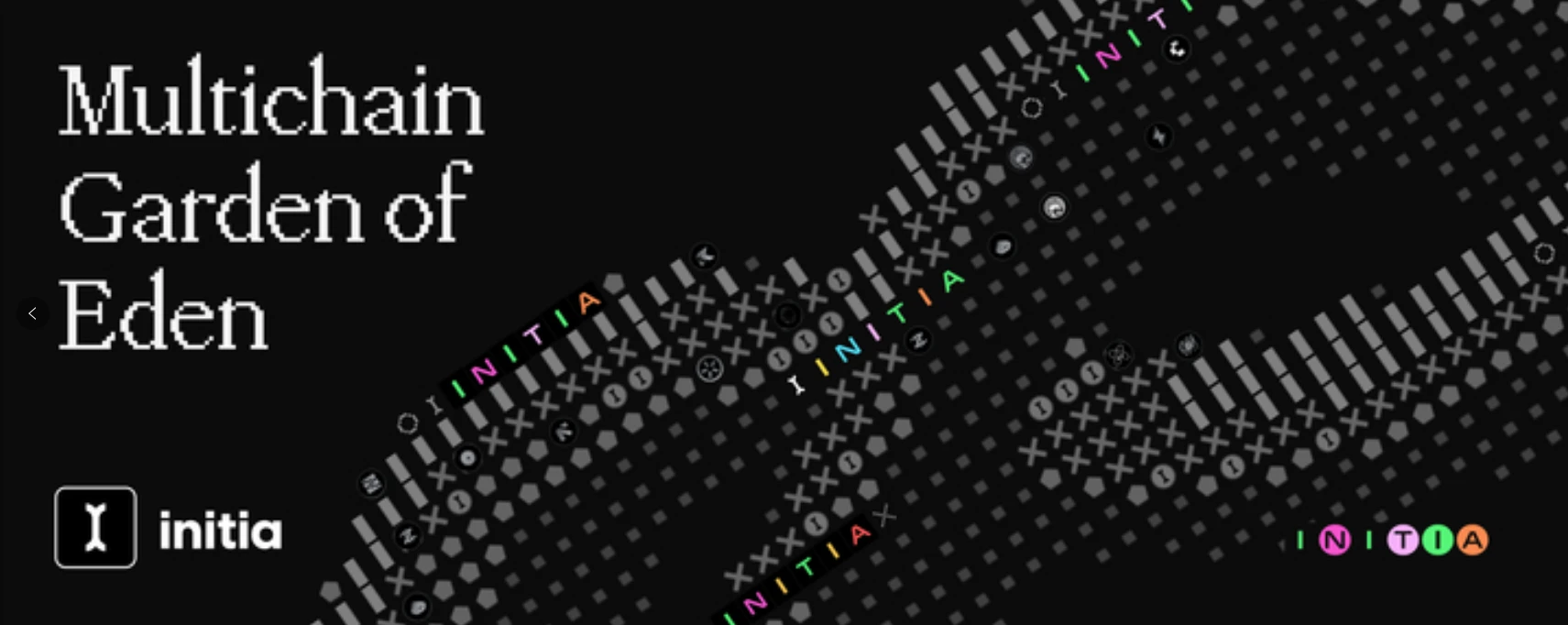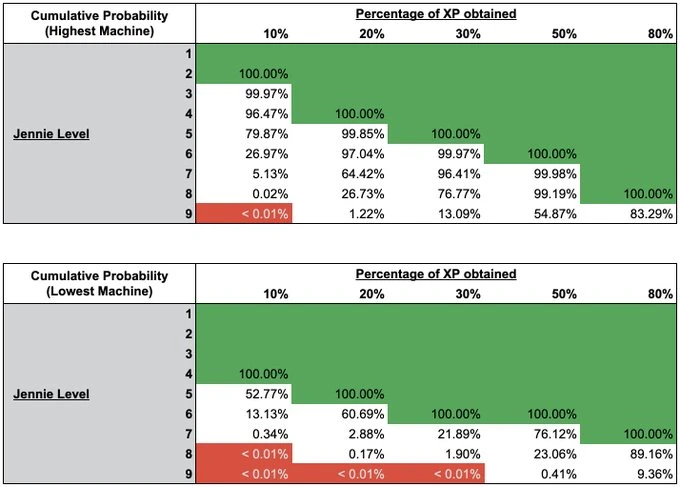Original Author: stan (Initia CEO)
Original Title: Initia's Path to Long-Term Success: Allocating the Airdrop to Loyal Users
Translation by: Asher (@Asher0210)_

Why Conduct an Airdrop?
The core goal of the airdrop is to maximize the conversion rate of ecosystem participants from test users to mainnet application users. This article will explore how to find a reasonable airdrop allocation plan for active Initia community participants based on real data and objective probability distributions (for background information on the Initia airdrop, please click here to jump to the official announcement).
The Initiation: Part One and The Initiation: Part Two active users serve as early adopters of the Multichain Garden of Eden, testing the limits of the infrastructure, pointing out difficult-to-use interfaces, and continuously providing improvement suggestions. Additionally, this category of users accounts for the majority of independent accounts, so about 90% of the total airdrop is allocated to this group.
Testnet Participants (89.46%)
Data Analysis
Many users hope that XP will be the primary criterion for airdrop allocation. However, as emphasized in the early testnet plan, raising Jennie’s level is the most important task. To find the best balance, Jennie’s level is only used to determine the base allocation and is significantly adjusted based on the number of tasks completed in the second phase of the testnet. Jennie’s level is highly correlated with XP range and helps reward users who are methodical and cautious in their decision-making (for example, not feeding the cheapest food on the first day but making decisions by the weekend).
The team is data-driven in decision-making. When designing the airdrop allocation plan, the team calculated the probabilities of reaching each level after acquiring a certain proportion of total XP, based on the following assumptions:
Users will consume all XP by the end of each week;
Whenever steak appears, it will be prioritized for Jennie;
If steak is not obtained, users will attempt to synthesize it;
If synthesis is not possible, users will feed Jennie the highest-level food available.

The first and second tables show the probabilities of reaching each level under the most expensive and cheapest scenarios, with the green area indicating users who are 100% guaranteed to reach or exceed the corresponding level. Under the assumption of moderate XP growth, the median level (which is also the mode of the actual sample data) is approximately 6, a value that will be used in subsequent calculations. Additionally, it is important to note that the "total XP acquisition" does not include extra reward XP (such as XP given during events) and XP obtained from steak airdrops and sales, so the actual probabilities of reaching each level are underestimated.
Based on these probability distributions, a positive correlation function can be established to map Jennie’s level to the base score. This function has the following characteristics:
A gentle gradient in the early stages (low-level growth is slow);
A significant increase around levels 5-6 (rewarding more active users);
A flattening trend around levels 7-9 (avoiding over-rewarding extreme data points).
Thus, the airdrop allocation can focus on the top quartile of active users while avoiding excessive skewing at both ends of the distribution. In addition to Jennie’s level, five fixed tasks were set (such as collecting stickers and freezing Jennie). As mentioned earlier, the goal of the airdrop is to incentivize long-term, stable, and focused users. These tasks have no randomness (all requirements are clearly listed on the Initia XP interface), so users who complete more tasks can receive an increasing weighted coefficient. That is:
Users who complete 3 tasks gain more than those who complete 2 tasks;
The increase from 2 tasks to 3 tasks is greater than the increase from 1 task to 2 tasks.
The purpose of this approach is to compensate users who may have been affected by bad luck during the Jennie upgrade process.
Calculating the Optimal Allocation Algorithm

The table above summarizes the number of qualified users categorized by level and task completion. Users eligible for the airdrop must meet the following criteria:
Jennie’s level ≥ 3;
At least 2 fixed tasks completed.
Several key characteristics of the dataset:
Level is positively correlated with the number of tasks completed;
For specific Jennie levels, the proportion of users completing 5 tasks increases with level, indicating that higher-level users are generally more focused;
The distribution is right-skewed (more users with high task completion), indicating that users participating in the testnet are generally serious;
All users at level 9 completed all 5 tasks.
Based on these characteristics, the final allocation algorithm can be formulated:
The user’s base score is determined by Jennie’s level;
The number of tasks completed serves as an additional multiplicative coefficient, increasing non-linearly;
Final airdrop allocation: Calculate each user’s final score (base score × task weighting coefficient), and the INIT tokens each user ultimately receives are distributed based on that user’s score / total score of all qualified users, allocating 89.4626% of the total airdrop amount of 50,000,000 INIT.
The final distribution exhibits a good characteristic:
The allocation function monotonically increases with level and task completion;
The weight of task completion increases progressively;
Beyond a certain "effort threshold" (i.e., median level 6), users with higher completion will receive greater rewards.
For example: A user at (6,5) (level 6, with 5 stickers) will receive more rewards than a user at (7,4) (level 7, with 4 stickers), ensuring that above a certain effort threshold, consistent long-term participation is more important than just having a high level.
In short, at the low-level stage, the impact of level itself is significant; at the high-level stage, the impact of task completion is greater. The final result is that the airdrop more precisely incentivizes stable, serious, and active long-term users.
Interwoven Stack Partners (4.50%)
This portion of token distribution is relatively straightforward, aimed at attracting deep users of Interwoven Stack core technology to join the ecosystem. LayerZero and IBC advanced users are potential community members who can provide profound insights for building a truly seamless multichain experience. Additionally, advanced users holding milkTIA and depositing in DeFi protocols also qualify for the airdrop.
Initia's Interwoven Stack not only integrates Celestia's data availability, but its L1 Enshrined Liquidity mechanism also encourages increased liquidity for ordinary assets and various liquid staking tokens, which will be launched on the mainnet. Advanced users familiar with LST and DeFi economics are key drivers of L1 governance and application economic growth.
Social Contributors (6.04%)
This portion mainly consists of contributions from Discord, Telegram, and X. In terms of distribution ratio, X seems to have a higher proportion, but in reality, the average amount of INIT tokens received by each user is as follows:
Discord: 1,199 INIT (a total of 417 independent users, 769 role allocations);
Telegram: 50 INIT;
X: 625 INIT.
Since the main community discussions for Initia occur on Discord and X, a focused analysis of the data distribution from these two channels is necessary:
The total allocation for X is 5 times that of Discord, but the number of benefiting users on X is 9 times that of Discord (4,000 vs 417);
The average allocation for the top 5% of Discord users is 5,246 INIT (minimum 2,904, maximum 7,648, excluding Discord moderators), while the average allocation for the top 5% of X users is only 2,044 INIT (minimum 1,812, maximum 2,276). This difference reflects a higher contribution threshold and stricter quality requirements for Discord;
The allocation for top Discord roles is close to that of advanced Jennie roles (around 2,000 INIT);
Discord users can receive allocations through multiple roles, while X users can improve their ranking through multiple high-quality tweets;
X interaction data based on Kaito's Initia leaderboard has been time-weighted (2024-2025) to ensure that long-term participants receive more rewards and to prevent major influencers from achieving excessively high rankings based solely on 1 or 2 highly interactive tweets.
The social contributor program aims to incentivize active community participation and facilitate in-depth discussions around the application chain ecosystem and its innovative mechanisms. Whether users choose Discord or X as their primary discussion platform, those core members who consistently contribute high-quality content and drive community development will receive airdrop rewards across multiple channels.
Anti-Witch Mechanism
During the testnet period, the team implemented a series of measures to minimize witch attacks, ensuring that genuine community members of the Initia ecosystem could fairly obtain resources. Although this initiative is controversial, Gitcoin Passport was introduced in the testnet faucet to reduce spam transactions and allow verified users to claim testnet tokens more smoothly. This strategy has proven effective, as a large number of (1,0) level Jennie (likely bots) became inactive as a result.
Additionally, the team designed a unique method to determine whether users submitted transactions through the official Initia frontend or interacted directly with the contract. In the XP scoring process, Initia's backend submits a Merkle root of user scores to the XP contract weekly. When users claim XP, they need to submit a Merkle proof obtained from the backend. A clever mechanism was added to this process: while providing genuine proof, the backend also generates a forged Merkle proof, which is composed of real proofs. The team then makes slight modifications to this forged proof on the official frontend and verifies whether this modification occurs on the contract side. If users claim XP through the official frontend, the system correctly identifies that they used the frontend; however, if users directly call the contract to claim XP, the system marks them as users who bypassed the UI to execute scripts directly.
Although this mechanism is not directly used to exclude users, it is very useful in identifying potential witch groups. To the team's knowledge, this is the first time a similar method has been used for screening in the industry. However, since this strategy may be difficult to reuse once widely known, its long-term effectiveness may be affected. Collaborating with Allium, the team analyzed potential witch accounts within various groups and employed a series of screening methods, including:
Transaction Count: Defining a data window of about n days and calculating the number of transactions sent by users. This method can filter out simple bots that perform the same number of transactions across multiple accounts within a given time period;
Function Call Sequence: Some bot groups execute transactions in the exact same function call order, creating recognizable behavior patterns;
Transaction Intervals: Analyzing the block intervals between a series of transactions, automated operations typically maintain very short intervals between multiple transactions. Additionally, if there are repeated transaction batches or patterns over a longer time frame (several hours or days), it may indicate that the account belongs to automated operations or script batch accounts.
It is important to note that the above methods are only part of the screening process, and the filtering algorithm ultimately adopted by the team is more complex. Furthermore, accounts that only meet a single screening criterion will not be directly excluded; instead, multiple factors will be combined for comprehensive judgment to minimize the possibility of false positives.
Summary
This airdrop is just the first step in distributing initial ownership and liquidity to the Interwoven ecosystem. Through Initia's core mechanisms, Enshrined Liquidity and Vested Interest Program (VIP), a total of 50% of the token supply will be used for long-term application ecosystem incentives. The team looks forward to the moment when L1 governance drives capital and liquidity allocation, as well as the sustainable growth of L2 applications under quantifiable KPI metrics.
See you on the mainnet.
免责声明:本文章仅代表作者个人观点,不代表本平台的立场和观点。本文章仅供信息分享,不构成对任何人的任何投资建议。用户与作者之间的任何争议,与本平台无关。如网页中刊载的文章或图片涉及侵权,请提供相关的权利证明和身份证明发送邮件到support@aicoin.com,本平台相关工作人员将会进行核查。




